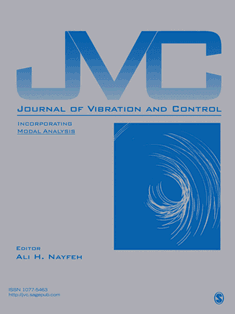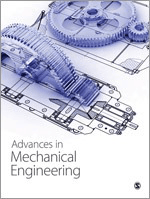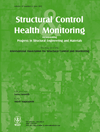
JOURNAL OF VIBRATION AND CONTROL
Scope & Guideline
Leading the Charge in Vibration Research and Applications
Introduction
Aims and Scopes
- Vibration Control Techniques:
Research on various methods for controlling vibrations in mechanical systems, including active, passive, and semi-active control strategies. - Structural Dynamics:
Studies focused on the dynamic behavior of structures under various loading conditions, including the analysis of vibrations in bridges, buildings, and other infrastructures. - Fault Diagnosis and Monitoring:
Development of techniques for the detection and diagnosis of faults in mechanical systems, particularly using vibration analysis and machine learning methodologies. - Acoustic and Vibro-Acoustic Analysis:
Exploration of sound transmission, noise control, and the interaction between vibrations and acoustic fields in different environments. - Modeling and Simulation:
Application of mathematical models and computer simulations to predict the behavior of vibrating systems and to design control strategies. - Material and Structural Innovations:
Investigation of new materials and structural designs that enhance vibration control, including the use of smart materials and metamaterials. - Applications in Transportation Systems:
Research on vibration control in transportation systems, such as railways, vehicles, and aerospace applications, focusing on ride comfort and structural integrity.
Trending and Emerging
- Machine Learning and AI in Vibration Analysis:
The incorporation of machine learning and artificial intelligence techniques for fault diagnosis, predictive maintenance, and control strategies is rapidly increasing, showcasing a shift towards data-driven methodologies. - Smart Materials and Adaptive Systems:
Research focusing on the use of smart materials, such as piezoelectric and shape memory alloys, for active vibration control is trending, highlighting innovations in material science. - Multi-Modal Vibration Control:
The exploration of control strategies for systems exhibiting multiple vibration modes is becoming more prevalent, addressing the complexities of modern mechanical systems. - Energy Harvesting Technologies:
Emerging research on vibration-based energy harvesting systems is gaining importance, reflecting a growing interest in sustainable and self-powered devices. - Advanced Simulation Techniques:
There is a notable rise in the use of advanced simulation techniques, including finite element analysis and hybrid modeling approaches, for predicting and controlling vibration behavior. - Cross-Disciplinary Applications:
Research integrating concepts from various fields such as robotics, aerospace, and civil engineering into vibration control is increasingly common, reflecting a trend towards collaborative and interdisciplinary studies.
Declining or Waning
- Traditional Mechanical Systems:
Research focusing on conventional mechanical systems without the integration of advanced technologies has become less prominent, as the field moves towards more innovative and complex systems. - Static Vibration Analysis:
Studies that focus solely on static vibration analysis, without consideration of dynamic effects, have waned as the importance of dynamic behavior becomes more recognized. - Basic Control Algorithms:
There has been a noticeable decrease in publications centered on basic control algorithms, with a shift towards more complex, adaptive, and intelligent control strategies. - Generic Material Studies:
Research that does not incorporate specific applications or advanced material properties has seen reduced attention as the focus shifts towards application-driven studies. - Non-Interdisciplinary Approaches:
Papers that do not integrate concepts from other disciplines (e.g., machine learning, data science) in vibration control have become less frequent, reflecting a trend towards interdisciplinary research.
Similar Journals

Advances in Mechanical Engineering
Elevating Research Standards in Mechanical EngineeringAdvances in Mechanical Engineering is a premier open-access journal published by SAGE Publications Ltd, dedicated to the advancement of theoretical and applied research in the field of mechanical engineering. With an ISSN of 1687-8132 and an E-ISSN of 1687-8140, this journal has been a vital resource for scholars and practitioners since its inception in 2009. Housed in the United States, it operates under a commitment to ensure free and immediate access to its high-quality content, enhancing collaboration and innovation across the global engineering community. With a noteworthy Q2 ranking in the mechanical engineering category and a solid Scopus rank placing it in the 59th percentile, the journal serves as an influential platform for cutting-edge research, theoretical advancements, and comprehensive reviews. As the field evolves, Advances in Mechanical Engineering continues to cater to the rigorous needs of researchers, professionals, and students, striving to transform knowledge into tangible engineering solutions. This journal's commitment to excellence makes it a significant contributor to the mechanical engineering field, encouraging dynamic discussions and implications for the future.

PROCEEDINGS OF THE INSTITUTION OF MECHANICAL ENGINEERS PART K-JOURNAL OF MULTI-BODY DYNAMICS
Driving Progress in Multi-Body Dynamics ScholarshipPROCEEDINGS OF THE INSTITUTION OF MECHANICAL ENGINEERS PART K-JOURNAL OF MULTI-BODY DYNAMICS, published by SAGE PUBLICATIONS LTD, stands as a pivotal platform for research dissemination in the fields of Mechanical Engineering and Condensed Matter Physics. With an ISSN of 1464-4193 and an E-ISSN of 2041-3068, this journal covers a broad spectrum of topics related to multi-body dynamics, aiming to facilitate the exchange of knowledge among researchers, professionals, and students alike. With its impressive ranking in the Q2 category for both Mechanical Engineering and Condensed Matter Physics, the journal is recognized for its quality and relevance, placing it within the top 64th and 58th percentiles of its respective fields according to Scopus rankings. Housed in the United Kingdom and accessible via various academic platforms, this journal operates without an open access policy, ensuring rigor in the peer-review process. By bridging theoretical understanding and practical applications, the journal continues to contribute significantly to advancements in multi-body dynamics, making it an essential resource for those engaged in cutting-edge engineering research.

Archive of Mechanical Engineering
Exploring the Dynamics of Materials and MechanicsThe Archive of Mechanical Engineering, published by Polska Akademia Nauk (Polish Academy of Sciences), is a distinguished platform for disseminating cutting-edge research in the fields of Mechanical Engineering and Mechanics of Materials. Since its inception, the journal has evolved and embraced an Open Access model since 2010, thereby enhancing accessibility and fostering wider dissemination of knowledge among researchers, professionals, and students globally. The journal covers a broad spectrum of topics, ensuring that vital advancements in mechanical engineering are communicated effectively. Recognized as a Q3 category journal in both its relevant categories as of 2023, the Archive continues to establish itself with a competitive Scopus Rank, aiming to elevate the standard of research and innovation. By merging historical insights with contemporary advancements, the journal serves as an essential resource for those seeking to delve into the evolution and future of mechanical engineering.

MECHANICAL ENGINEERING
Shaping the Future of Engineering Through Rigorous ResearchMECHANICAL ENGINEERING, published by the esteemed American Society of Mechanical Engineers (ASME), is a vital resource for professionals and researchers in the field of mechanical engineering. With a rich history that spans several decades, this journal has been pivotal in disseminating innovative research and advancements from 1968 to 1998 and from 2002 to 2024, fostering a deeper understanding of complex engineering principles. Although currently not an open access journal, it offers subscription-based access to its high-quality articles, enhancing the field's scholarship. As evidenced by its Q4 ranking in mechanical engineering and a current Scopus rank of #580 out of 672, MECHANICAL ENGINEERING serves as a platform for valuable contributions, albeit it is positioned among its peers within the 13th percentile. This journal is a beacon for those committed to staying at the forefront of mechanical engineering research and practice, encouraging discourse that shapes the future of the discipline.

Akustika
Advancing Knowledge in Acoustics and UltrasonicsAkustika is a premier journal dedicated to the field of acoustics and ultrasonics, published by STUDIO D-AKUSTIKA SRO in the Czech Republic. With an ISSN of 1801-9064, this journal provides a platform for cutting-edge research and development in acoustics, emphasizing advancements in both theoretical and practical applications. Although currently ranked in the Q4 category for Acoustics and Ultrasonics based on 2023 Scopus Ranks, the journal aims to foster growth and innovation within the community, offering invaluable insights for researchers, professionals, and students alike. It encompasses a wide-ranging scope that reflects the dynamic nature of acoustics, making it a vital resource for those engaged in this crucial field. With contributions dating back to 2012, Akustika is committed to promoting scientific dialogue and enhancing the understanding of sound in various environments.

APPLIED MATHEMATICS AND MECHANICS-ENGLISH EDITION
Empowering Research with Cutting-Edge Mathematical ApplicationsApplied Mathematics and Mechanics - English Edition is a prestigious journal published by Shanghai University, focusing on the interdisciplinary applications of mathematics and mechanics across various scientific and engineering domains. With an ISSN of 0253-4827 and an E-ISSN of 1573-2754, this journal has established itself as a vital resource since its inception in 1980, extending its coverage well into 2024. The journal boasts impressive Scopus rankings—placing it in the top 10% of the Applied Mathematics category and the top 20% in Mechanical Engineering and Mechanics of Materials—reflecting its significant impact and contribution to research. Currently categorized in the Q2 and Q1 quartiles, it caters to a diverse audience that includes researchers, professionals, and students seeking to explore cutting-edge developments and innovative methodologies in the field. Although the journal is not open access, it remains committed to disseminating high-quality research that addresses contemporary challenges in applied mathematics and mechanics, fostering a deeper understanding of their practical implications.

JOURNAL OF INTELLIGENT MATERIAL SYSTEMS AND STRUCTURES
Innovating the Intersection of Materials and Structural ApplicationsWelcome to the JOURNAL OF INTELLIGENT MATERIAL SYSTEMS AND STRUCTURES, a premier publication in the fields of Materials Science and Mechanical Engineering, published by SAGE Publications Ltd. With an impressive impact factor reflected in its Q2 quartile ranking in both categories, this journal serves as a vital resource for cutting-edge research and innovative applications in intelligent materials and structures. Since its inception in 1990, the journal has provided a platform for disseminating high-quality research, exploring the interplay between advanced materials and their structural applications. Researchers, professionals, and students alike will find valuable insights into current trends and discoveries, enhancing their understanding and fostering interdisciplinary collaborations. Although not currently offered as Open Access, the journal ensures rigorous peer-review standards, maintaining its relevance and credibility within the academic community. Whether you are searching for the latest advancements or seeking inspiration for your own research, the JOURNAL OF INTELLIGENT MATERIAL SYSTEMS AND STRUCTURES is essential reading for all invested in the future of material performance and intelligent systems.

Journal of Vibration Engineering & Technologies
Bridging Theory and Application in Vibration ScienceJournal of Vibration Engineering & Technologies, published by Springer Heidelberg in Switzerland, is a premier open-access journal dedicated to the expansive field of vibration engineering, focusing on both acoustics and mechanical engineering. With its ISSN 2523-3920 and E-ISSN 2523-3939, the journal has gained significant recognition, achieving a prestigious Q2 ranking in both Acoustics and Ultrasonics and Mechanical Engineering in the 2023 category quartiles. In just a decade since its inception in 2014, it has established a solid foothold in the academic community, as indicated by its Scopus ranks, placing it among the top journals in acoustics (Rank #17/44, 62nd percentile) and in mechanical engineering (Rank #269/672, 60th percentile). The journal aims to disseminate cutting-edge research that advances the understanding and applications of vibration technologies, fostering dialogue among researchers, educators, and industry professionals. As an essential resource for those in academia and industry alike, the Journal of Vibration Engineering & Technologies invites contributions that challenge existing paradigms and propel innovation in the field.

JOURNAL OF SOUND AND VIBRATION
Innovating the intersection of mechanics and acoustics.The JOURNAL OF SOUND AND VIBRATION, published by Academic Press Ltd - Elsevier Science Ltd, stands as a pivotal platform in the fields of Acoustics and Ultrasonics, Mechanical Engineering, and Mechanics of Materials. Since its inception in 1964, the journal has served as a beacon for researchers and practitioners looking to share and advance their knowledge on sound and vibration phenomena. With an impressive Q1 ranking in multiple categories and a Scopus ranking placing it in the top 10% of significant journals in related fields, it offers a high-impact venue for disseminating innovative research. The journal's well-rounded scope intersects fundamental and applied science, ensuring it remains relevant to a diverse audience, including students and professionals aiming to deepen their understanding of dynamic mechanical systems. Although primarily subscription-based, the journal's commitment to academic excellence makes it a valuable resource for all involved in the study and application of sound and vibration research, contributing significantly to advancements across engineering and physics disciplines.

Structural Control & Health Monitoring
Pioneering Research for Safer, Smarter StructuresStructural Control & Health Monitoring, published by John Wiley & Sons Ltd, is a premier academic journal dedicated to advancing the fields of structural engineering, building and construction, and mechanics of materials. With a commendable Q1 status in three key categories and a strong presence in the scientific community, this journal boasts an impressive ranking of #20 in Building and Construction and #35 in Civil and Structural Engineering, reflecting its significant impact and relevance. Since transitioning to Open Access in 2023, the journal provides unrestricted access to innovative research, promoting a wider dissemination of crucial findings and methodologies. It specializes in the dissemination of advancements in health monitoring techniques, structural integrity evaluation, and control systems, aimed at researchers, professionals, and students seeking to enhance their understanding of contemporary challenges in structural management. With converged years spanning from 2004 to 2024, Structural Control & Health Monitoring remains committed to fostering a collaborative environment where cutting-edge research meets practical applications, positioning itself as an essential resource for those at the forefront of the engineering discipline.